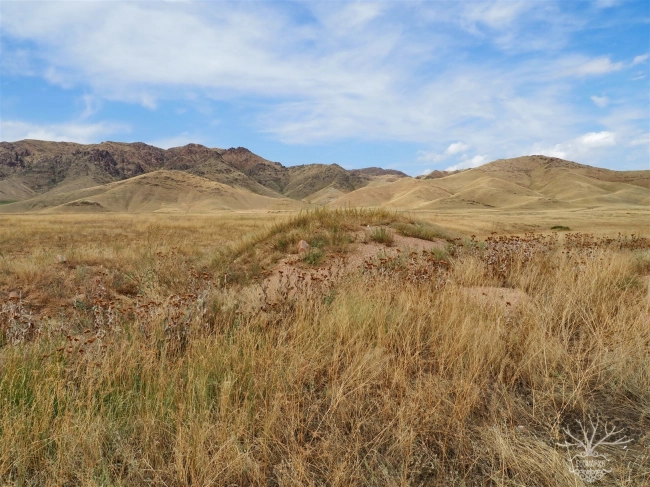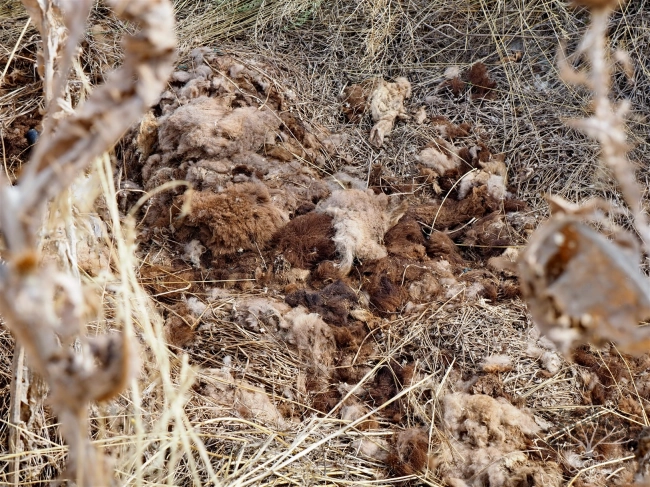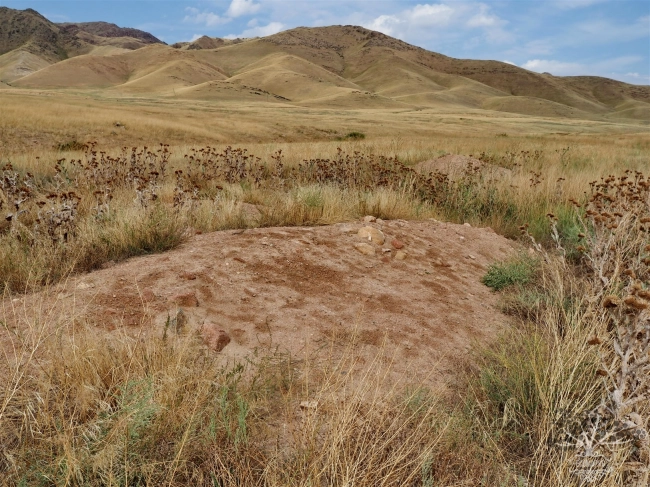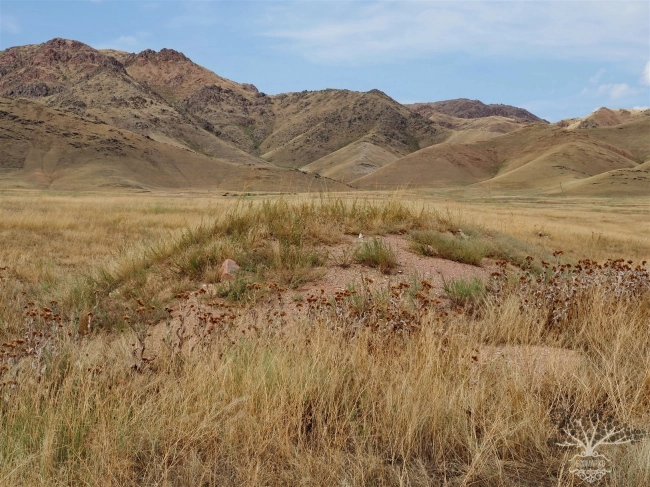Old Cattle Cemetery near Mount Meerim-Tash
Coordinates: 42.452038, 72.757024
Old animal burial sites are places where the remains of animals that died from various diseases or were destroyed to prevent the spread of epidemics are buried. Although such burials are an important biosecurity measure, over time they can become a serious threat to human health and the environment. The danger of burial sites is often underestimated, especially if they are located in areas not equipped according to modern sanitary standards. This article will examine the threats posed by old animal burial sites and how their negative impact can be prevented.
Pathogens and Diseases The main danger of old animal burial sites lies in the possibility of releasing pathogenic microorganisms, such as bacteria, viruses, and spores. If animals were buried due to epidemics or infectious diseases, pathogens can remain in the soil for decades. One of the most well-known examples is anthrax, the causative agent of which can survive in spore form in the ground for many years. If the soil or animal remains are disturbed, for example, due to excavation, construction work, or natural disasters, spores can enter the air, water, or surfaces, posing a threat to human health.
Water Pollution If old animal burial sites are located near bodies of water or groundwater aquifers, they can become a source of water pollution. The decomposition of animal tissues can lead to the release of hazardous substances, such as ammonia, nitrates, and pathogens, which seep into groundwater. This can lead to contamination of drinking water sources, posing a serious danger to humans, as well as wildlife and ecosystems.
Toxic Substances Various chemicals that may have been toxic were used in the past for the disposal of animal remains. For example, chemicals such as formaldehyde or chlorine-containing substances may have been used for disinfection or to slow down decomposition. Over time, these toxic substances can leach into the soil and enter the environment, causing poisoning and negative effects on flora and fauna.
Soil Erosion and Natural Disasters Natural processes such as soil erosion, flooding, or landslides can disrupt the integrity of burial sites, leading to the exposure of remains and the leaching of pathogens. Additionally, animals and humans may accidentally disturb an old burial site, for example, during construction or agricultural work, increasing the risk of releasing pathogens into the environment.
Disruption of Ecosystems Burial sites can cause significant harm to the environment. Pollution of soil and water bodies with toxic substances and pathogens disrupts the natural balance of ecosystems, which can lead to the death of animals, plants, and microorganisms. Restoring ecosystems after such damage can take decades, especially if water resources are contaminated.
Threats to Biodiversity Diseases spreading from contaminated burial sites can affect wild animals and livestock, posing a threat to biodiversity. The spread of such infections can cause outbreaks among wild animal populations and lead to the extinction of rare species.
Infectious Diseases People working near burial sites or living nearby are at risk of contracting diseases. For example, if a burial site was used for the burial of animals that died from anthrax, the risk of contracting this deadly disease remains for decades. Infection can occur through direct contact with soil, water, or by inhaling bacterial spores.
Food Chains Pollution of water sources and soil can lead to the accumulation of toxins and pathogens in food chains. For example, if livestock drinks water contaminated with anthrax, it can lead to the spread of infection among animals that may then be used for food.
Prevention Measures
Mapping Old Burial Sites It is important to conduct a thorough inventory and mapping of all known old animal burial sites. This will allow for better monitoring of areas where potentially hazardous sites are located and prevent accidental excavations or construction on these sites.
Fencing and Marking of Areas All old burial sites should be fenced and marked with appropriate warning signs to prevent people and animals from accidentally entering these areas.
Monitoring Soil and Water Quality Regular monitoring of soil and water quality near burial sites should be conducted. This will allow for timely detection of contamination and the implementation of remediation measures.
Public Awareness Efforts It is necessary to inform the population, especially rural and remote communities, about the risks associated with old burial sites. This can include open lessons, publications, lectures, and seminars to ensure that people know how to protect themselves and their environment from potential threats.
Old animal burial sites can pose a serious danger to human health and the environment, especially if they have not been properly managed or have been forgotten. Soil and water pollution, pathogens, and toxic substances can persist for decades, threatening ecosystems and human life. It is important to conduct regular research, monitoring, and public awareness efforts to minimize risk and protect the environment and the health of future generations.
Old animal burial sites are places where the remains of animals that died from various diseases or were destroyed to prevent the spread of epidemics are buried. Although such burials are an important biosecurity measure, over time they can become a serious threat to human health and the environment. The danger of burial sites is often underestimated, especially if they are located in areas not equipped according to modern sanitary standards. This article will examine the threats posed by old animal burial sites and how their negative impact can be prevented.
Pathogens and Diseases The main danger of old animal burial sites lies in the possibility of releasing pathogenic microorganisms, such as bacteria, viruses, and spores. If animals were buried due to epidemics or infectious diseases, pathogens can remain in the soil for decades. One of the most well-known examples is anthrax, the causative agent of which can survive in spore form in the ground for many years. If the soil or animal remains are disturbed, for example, due to excavation, construction work, or natural disasters, spores can enter the air, water, or surfaces, posing a threat to human health.
Water Pollution If old animal burial sites are located near bodies of water or groundwater aquifers, they can become a source of water pollution. The decomposition of animal tissues can lead to the release of hazardous substances, such as ammonia, nitrates, and pathogens, which seep into groundwater. This can lead to contamination of drinking water sources, posing a serious danger to humans, as well as wildlife and ecosystems.
Toxic Substances Various chemicals that may have been toxic were used in the past for the disposal of animal remains. For example, chemicals such as formaldehyde or chlorine-containing substances may have been used for disinfection or to slow down decomposition. Over time, these toxic substances can leach into the soil and enter the environment, causing poisoning and negative effects on flora and fauna.
Soil Erosion and Natural Disasters Natural processes such as soil erosion, flooding, or landslides can disrupt the integrity of burial sites, leading to the exposure of remains and the leaching of pathogens. Additionally, animals and humans may accidentally disturb an old burial site, for example, during construction or agricultural work, increasing the risk of releasing pathogens into the environment.
Disruption of Ecosystems Burial sites can cause significant harm to the environment. Pollution of soil and water bodies with toxic substances and pathogens disrupts the natural balance of ecosystems, which can lead to the death of animals, plants, and microorganisms. Restoring ecosystems after such damage can take decades, especially if water resources are contaminated.
Threats to Biodiversity Diseases spreading from contaminated burial sites can affect wild animals and livestock, posing a threat to biodiversity. The spread of such infections can cause outbreaks among wild animal populations and lead to the extinction of rare species.
Infectious Diseases People working near burial sites or living nearby are at risk of contracting diseases. For example, if a burial site was used for the burial of animals that died from anthrax, the risk of contracting this deadly disease remains for decades. Infection can occur through direct contact with soil, water, or by inhaling bacterial spores.
Food Chains Pollution of water sources and soil can lead to the accumulation of toxins and pathogens in food chains. For example, if livestock drinks water contaminated with anthrax, it can lead to the spread of infection among animals that may then be used for food.
Prevention Measures
Mapping Old Burial Sites It is important to conduct a thorough inventory and mapping of all known old animal burial sites. This will allow for better monitoring of areas where potentially hazardous sites are located and prevent accidental excavations or construction on these sites.
Fencing and Marking of Areas All old burial sites should be fenced and marked with appropriate warning signs to prevent people and animals from accidentally entering these areas.
Monitoring Soil and Water Quality Regular monitoring of soil and water quality near burial sites should be conducted. This will allow for timely detection of contamination and the implementation of remediation measures.
Public Awareness Efforts It is necessary to inform the population, especially rural and remote communities, about the risks associated with old burial sites. This can include open lessons, publications, lectures, and seminars to ensure that people know how to protect themselves and their environment from potential threats.
Old animal burial sites can pose a serious danger to human health and the environment, especially if they have not been properly managed or have been forgotten. Soil and water pollution, pathogens, and toxic substances can persist for decades, threatening ecosystems and human life. It is important to conduct regular research, monitoring, and public awareness efforts to minimize risk and protect the environment and the health of future generations.
This research was conducted with the support of the Global Greengrants Fund (GGF), one of the leading donor organizations in the world that supports the efforts of ordinary people to protect the planet Earth. #GlobalGreengrantsFund #GreengrantsFund #Greengrants #GGF #GlobalGreengrantsFund



























Attention: Information based on submitted complaints